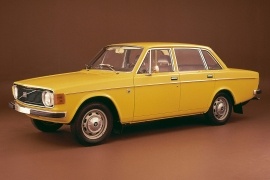VOLVO 144 Models/Series Timeline, Specifications & Photos
First production year: 1966
Engines: Gasoline
Volvo ended the Amazon series and introduced the 140 lineup in 1966, along with a new naming system that followed until the late '80s and the 144 was one of them.
The new naming system showed the first number as the series, the second represented the number of cylinders, and the last was for the number of doors. This means the 144 was the first series of the new wave with a four-cylinder engine and four doors. Its siblings were the 142 (the coupe) and the 145 (the station wagon). This car was significant in Volvo's heritage since it defined a design concept that continued until 1998, when it died along with the 960 model.
In 1967, when many other automakers tried to shape their cars with rounded edges, Volvo did the opposite. It made the 144 with flat surfaces, just slightly shaved corners, and an overall rugged look. The only round parts on the bodywork were the headlights. Between them was a flat grille with horizontal slats divided in two. From its sides, the wedged shapes continued on the greenhouse and at the back. Even the taillights were squared and divided into rectangular parts for braking and reversing lights, turn signals, and parking lights.
Inside, the carmaker kept the same wedged shapes of the exterior. It even offered a center stack that hosted the ventilation controls for the upper trim levels. The flat bucket seats at the front inspired the one behind the wheel to drive slower since they offered no side support. But at least the car came fitted with safety belts, which was a huge safety improvement.
Under the hood, Volvo installed the same 1.8-liter powerplant from the rest of the 140 range, and it was mated either with a four-speed manual, a four-speed manual with electrical overdrive, or a three-speed automatic.
